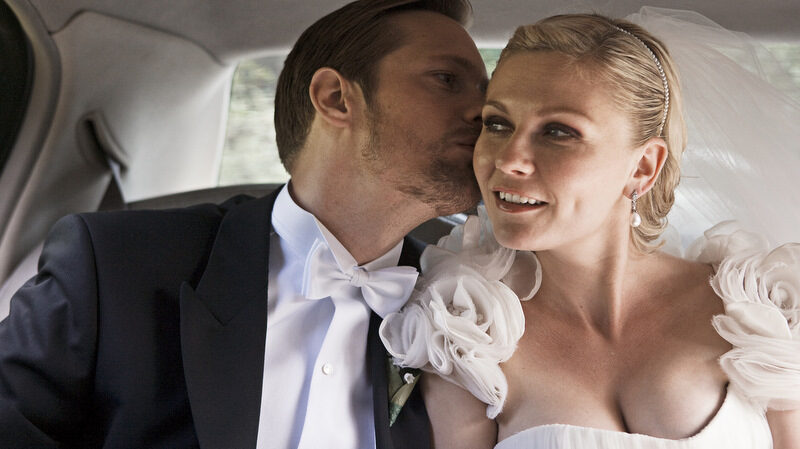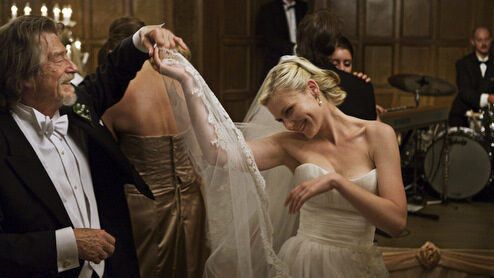Review: Melancholia | Clothes on Film

Starring: Kirsten Dunst, Charlotte Gainsbourg, Kiefer Sutherland
Directed By: Lars von Trier
The most exquisite fashion promo ever made. Only a demeaning statement if you consider fashion a frivolous construct of self-expression; Lars von Trier does not.
Kirsten Dunst plays Justine, a despondent soul who cannot face the enforced happiness of her bourgeois wedding day yet can passively accept the annihilation of earth due to its collision with the planet ‘Melancholia’. Obviously the destruction of all mankind is a situation beyond her control, so she all but welcomes it. As someone who spends every single day trying to think of a reason to live, Justine is thankful the decision has been taken out of her hands.

John Hurt as Dexter and Kirsten Dunst as Justine. Dunst apparently hated the ostentatious style of her character’s wedding dress but loved how it worked as costume.
Justine can be a difficult character to sympathise with. Despite the love and attention of those around her, in particular her anxious sister, Claire (Charlotte Gainsbourg), she sabotages the most joyous occasion of her life through constant defiling of her spectacular ruche wedding dress by tearing, soiling and eventually polluting with shame. The only respite Justine receives from its corset prison is an impromptu bath mid-reception, something she initially struggles to contemplate later in the story – again because the situation is forced on her.
And yet when Justine is released from the dress later that evening, she immediately asks her bewildered husband, Michael (Alexander Skarsgård), to strap her back in. Her psychosis actually enjoys the dress’ suffocating constrictiveness; it gives her justification to rebel, which she then proceeds to do in the most divisive way imaginable.
What is easy to overlook in analysis of Justine is that she absolutely cannot help herself. Depression is not a choice, it is a compulsion; a deep, gut dwelling pain that refuses to abate. For Justine the best she can hope for is a reprieve. In a clever second act pay off, this occurs when Claire crumbles into a state of mental collapse at her swiftly impending and inevitable death.

Dunst and Charlotte Gainsbourg as Claire. Costume designer for Melancholia, Manon Rasmussen, has worked several of von Trier’s films including Breaking the Waves (1996), Dancer in the Dark (2000) and Dogville (2003).
Now the narrative shifts ahead several weeks to tell Claire’s story. Justine is free from her bridal binds in skinny jeans, plain v-neck tee and at one point an especially discreet natural linen shift dress; uninspired couture efficiency only the very rich can appreciate. Ready to wear designer fashion comes to release Justine in a way it permanently stifles so many others.
Claire is attired similarly to Justine, although her silhouette is more flowing and willowy. She is vague; she drifts, whereas liberated Justine is cold and resolute. Throughout Melancholia, von Trier suggests a fascination with clothes, their composition and interpretation (the metaphorical grip of Justine’s depression is represented by creeping fabric during one of the opening tableaux). Manon Rasmussen’s costume design is a sumptuous portrait of contemporary expression – much like the film itself. Melancholia is a heartbreakingly beautiful experience, one to selfishly guard and treasure.
Melancholia was released in the UK on 30th September.
© 2011 – 2012, Chris Laverty.
